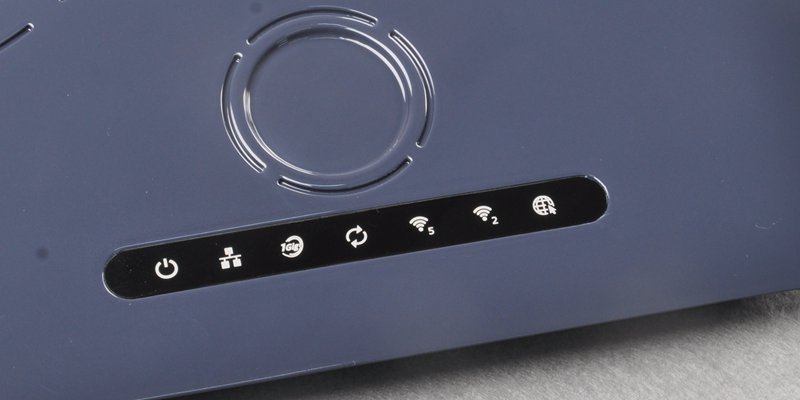- April 14, 2023
Over the years, several products in different industries have featured one or more printed images or texts. Manufacturers used different printing technologies, such as screen printing and pad printing technique, to transfer these logos and texts onto these products.
This article gives a well-detailed guide on the screen printing process, including a stepwise breakdown of the process. You’ll also learn the various types of screen printing, their applications, and a comparison between screen and digital printing.
What is Screen Printing?
Screen printing is a traditional post-finishing technique that involves pressing ink through a stenciled mesh onto the surface of a substrate to achieve printed designs. It is also called silkscreen printing or serigraph. This process is widely used in different industries nowadays as it is compatible with different materials, unlimited repetition, and high-level color vibrancy in designs.
In addition, screen printing produces a thicker ink print than most printing methods. Although manufacturers commonly use screen printing on plastic and fabrics, with special inks, you can also print on other materials such as plastics, ceramic, glass, etc.
Silk Screen Printing Process: A Step-by-Step Guide
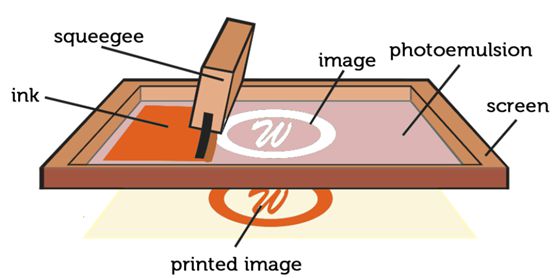
Here is a breakdown of the screen printing steps:
Step 1: Design Drafting
The first thing you need in the silk screening process is the original image or text from which the printer will make copies of the design. Then, the prints of the selected design or pattern are on a transparent acetate film.
Step 2: Choose and Prepare the Mesh Screen
The next step is to choose a mesh screen for the silk screening operation. However, it would help if you chose a mesh screen based on the material or fabric type for the printing and the design complexities. After then, cover the mesh screen with a light-sensitive emulsion layer.
Step 3: Expose the Emulsion Paint to Light Source
Place the acetate sheet carrying the design on the mesh screen, exposing both to bright light. It helps to harden the emulsion paint. If the design uses several colors, you should consider using a different mesh screen for each color ink.
Step 4: Prepare the Stencil
The screen area not covered by the printed design hardens after some time, while any emulsion part not hardened by the concentrated light gets washed away. It creates an excellent imprint of the desired design on the mesh screen. The screen is thoroughly dried after the wash-up while the stencil is processed for subsequent use.
Step 5: Prepare for Screen Printing
Set up the mesh with the design on the printing press with screws. Usually, manufacturers have used manual and automatic presses. So, an automatic printing press is your best option when your project requires multicolor printing. The fabric or any other material to be printed on is set on a printing board underneath the screen.
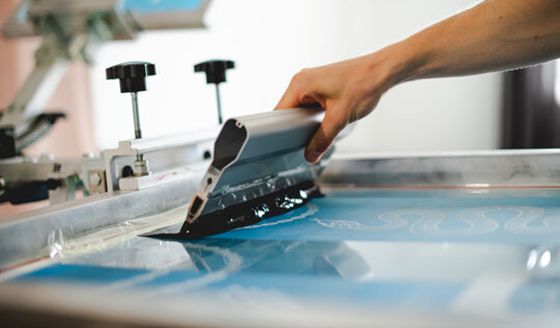
Step 6: Print the Design
Lower the screen to come close to the fabric while you pour the ink on the screen. Use a squeegee to press the ink from the screen onto the object carefully. The ink forms the design’s imprints onto the fabric when the ink goes beneath the screen to the material. When printing multiple objects, you must position a new object or substrate under the screen and repeat the process.
Step 7: Heat-Cure and Finish the Print
The transferred pain on the item dries up entirely with the help of a dryer. After drying, you must wash and check the final product for residue before pushing it to the market. Also, you must wash off the mesh screen with chemicals and prepare it for subsequent use.
Typical Screen Printing Equipment
Now that you understand how screen printing works, let’s check the typical equipment involved in the process.
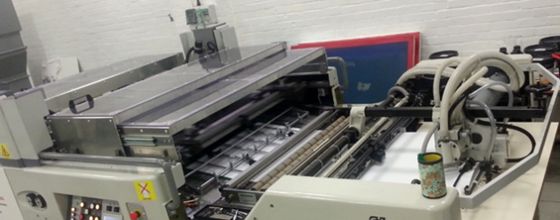
1. Printer and Films
A printer that can create designs on the stencils is the first on the list of things you need to achieve custom silk screen printing. The printer prints required designs onto transparent films known as acetate film. You must use a different acetate film for each color and later for making stencils.
2. Mesh Screen
It is the following most crucial material in silkscreen printing. You must place the transparent film on the mesh screen to impress the stencil. The mesh screens originally come from silk threads, and several options nowadays are made from polyester fabrics. In addition, the mesh screen’s thread count, thickness, and texture decide the final prints’ quality.
3. The Inks
The inks or pigments used for silkscreen printing play a crucial role with many options. There are specialized inks for fine screen printing that provides brilliant effects on the final products. Printing companies commonly utilize texturized inks, puff inks, or glittery inks to create a unique look on their silk screen production.
4. Squeegees
Squeegees are simple rubber blades joined with a handle made of plastic or wood. These blades push the ink through the mesh screen until it reaches the printed object. Squeegees used in the silkscreen method are of various designs. Generally, the mesh screen frame often determines the squeegee types to use.
5. Printing Press
The printing press is an indispensable tool that firmly holds the mesh screen between prints. It allows the changing ease of printed objects below the mesh screen.
6. Belt Dryer
The belt dryer helps heat the ink to a temperature that ensures the print’s longevity and safeguards it from fading or cracking.
Types of Screen Printing Process
The silk screening process comes in different types, producing varying surface finish results. So it is best to understand the different types to know the best fit for your product. Here are the common screen printing techniques.
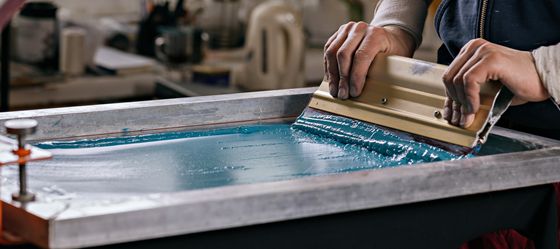
Grayscale Printing
This screen printing type is an impressive technique for printing full-color images as one-color half-tones or greyscales. However, the prints appear with great details when more dots are in the half-tone. This process differs from a black-and-white method. It extracts only the color scales, CMY, or RGB in shades of grey. Greyscale printing is a cost-saving screen printing method generally used to print designs in white and black on fabrics.
Spot-Color Printing
Spot-color screen printing is the most used technique by manufacturers and product designers. It uses the ink’s stock colors by printing it via the mesh’s stencil. The spot color technique is more straightforward than most screen printing techniques and creates a brilliant solid spot of color. It is a perfect option for printing on hoodies, jackets, and t-shirts.
CMYK (4-color Printing)
The CMYK or 4-color printing is the most complicated screen printing type. It usually involves four primary colors: black, magenta, cyan, and yellow. The combination of these colors forms the color tones needed. Although you can combine the colors manually, it is advisable to mix them automatically to get the best results.
Duotone Printing
The Duotone printing method combines two half-tones to print the same image using two colors. It prints the first black half-tone with black ink while using color ink to print the second half-tone. This printing method is identical to sepia-toned print in photography. It offers an artsy and elegant effect.
Half-tone Printing
Half-tone printing involves the printing of single colors in gradients. The whole process adopts a single ink color, usually half-toned, so the printing gives a different shade when viewed from afar. This technique is suitable for multicolor printing appearance without actually printing in multiple colors.
Simulated Process Printing
This technique involves the combination of spot color printing and four-color printing techniques. Since the simulated printing process is ideal for darker and lighter shades, it is versatile and well-known to manufacturers and designers who must create photorealistic print detail.
Pros and Cons of Screen Printing
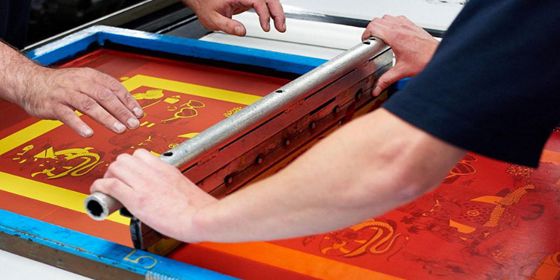
Pros of Screen Printing
Screen printing is an efficient process with enormous advantages in various industries. Here are some of the significant benefits of the screen printing process:
Simplified Process
The printing process, done manually or automatically, is relatively straightforward. More importantly, the tools you need to print are not complicated or too expensive to replace.
Multipurpose/Versatile Method
The silk screen printing process is compatible with different products irrespective of shape, size, and material. This process allows printing on the plane and shapes objects with uneven or complex shapes like spherical surfaces. Likewise, this process allows the usage of multiple colors in printing.
Durable Designs
This process uses heavy ink coverage to achieve a colorful and neat design appearance, ensuring the longevity and quality of the printed design. The ink blends with the fabric, ensuring it doesn’t crack or fade away quickly.
More importantly, applying certain coatings and additives can make the ink resistant to moisture, UV rays, chemicals, and scratches. It makes the screen-printed components suitable for outdoor use and harsh environments without degrading.
Efficiency and Speed
Unlike other printing techniques, screen printing is fast and the most efficient as long as the screen is ready. It is the ideal option for projects that requires design repetitions.
Cons of Screen Printing
Although screen printing is a versatile technique with a wide range of benefits, there are downsides to the process. Here are some of them:
High Setup Cost
The initial setup cost for the silk screen printing technique is expensive. As a result, it is best to outsource products that require screen printing to a specialized supplier.
More Color Variants, More Costs
Screen printing can only create one color at a time, making the process relatively slow and challenging for multicolor printing. The process costs more as you must create a new screen for each color. Likewise, there is a high tendency for color registration inadequacy in screen printing, leading to increased costs and product scrap rates.
Applications of Silk Screen Printing
Screen printing technology is versatile and provides impressive results across different industries. Here are the typical applications of silk screen printing.
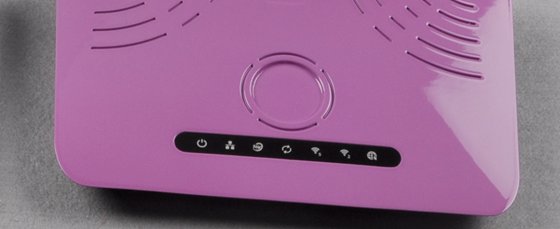
Electronics Printing
The electronics industry benefits from the silk screen printing technique as demands for electronic devices increase. This printing process is efficient and dependable because of its better printing methods, materials, and equipment.
Textile Printing
Silk screen printing is a well-known technique in the textile industry. This industry benefits from this technique in t-shirt printing and various image designing. More importantly, custom silk screen printing is available in several printing setups, allowing for more flexibility in fabric printing.
Glass and Ceramic
Screen printing technology offers considerable help in producing glass and ceramic items with printed images and texts for consumer and industrial applications. This printing technique is unique because it helps this industry overcome various significant glass decoration challenges.
Window Stickers and Displays
Screen printing is ideal for branding and displaying information and decals on windows. Silk screening’s vibrant colors help these printing to serve as a promotional point of sale for most businesses and workspaces.
Screen Printing vs. Digital Printing: The Basic Differences
Screen printing is relatively primitive compared to digital printing. Digital printing is an automated (computer-controlled) technique that prints images and texts on desired surfaces using printing machines. The process involves creating a design or artwork on a computer and converting digital images into prints on any material of choice. Digital printing does not include all the mechanical steps involved in conventional printing.
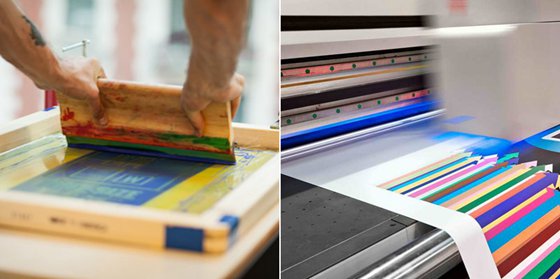
This section discusses the basics of screen printing vs. digital printing so you can easily choose the best technique for your printing project. Here are the significant differences:
Setup Time and Costs
When using the screen printing technique, you must create and set each screen up before printing. Likewise, you need stencils and other tools for the operation. These screens are usually disposed of after printing each design. Thus, screen printing has high setup costs and screen fees, unlike digital printing.
Color Payoff
When color is a priority in printing, screen printing is a perfect choice. This is because the ink uses spot colors while digital presses utilize a CMYK four-color technique causing a limited color range. As a result, digital presses cannot achieve some of the vibrant colors that screen printing provides, including greens, reds, greys, and oranges.
Quantity
Screen printing is ideal when you spread setup costs over many products. You complete more prints per hour and faster with screen print than with digital presses. Hence, high volumes become cheaper irrespective of the setup costs. Meanwhile, low-quantity printing is more cost-effective with digital presses due to its low or non-existent setup costs.
Ink Adhesion and Durability
Inks used in screen printing are famous for adhering to various surfaces (i.e., glass, wood, plastic, metals, etc.). Meanwhile, digital inks have existed for some time and are available in different series that can adhere to various substrates. However, these digital inks are more expensive than the ink used in screen printing.
Moreover, screen printing on metal is more resistant to weather conditions and more durable than digital ink. In addition, you can add a screen-printed UV-resistant clear coat to a substrate for additional protection for the printed image. Unfortunately, a clear digital top coating is not available for digital printing.
Conclusion
Screen printing is a reliable technique for printing images and texts on your products made with different materials. Consider using this technique as it is flexible and straightforward. However, it would help to understand the basics of the process and its types to know how well it fits your next project.
WayKen is here to provide custom finishes for your projects. We are a reliable partner for high-quality screen printing and other post-finish options. You will be confident to get the products that meet the strict specification. Just contact us today and get a free quote!
FAQs
Can screen print crack?
Screen prints can fade, crack, or wash out thoroughly. However, you can cure your screen-printed products to ensure ink adhesion and durability.
Can I remove the silk printing?
You can remove silk printing on a product using a nail polish remover or acetone. Acetone is a chemical component commonly found in nail polish remover. It efficiently dissolves and removes old and cracked screen-printed designs.
Which fabric material is best for silk screening?
The ideal fabric choice to silk screen on is cotton and cotton blends. The cotton yarn has excellent multifilament properties, allowing it to absorb ink easily better than synthetics.

